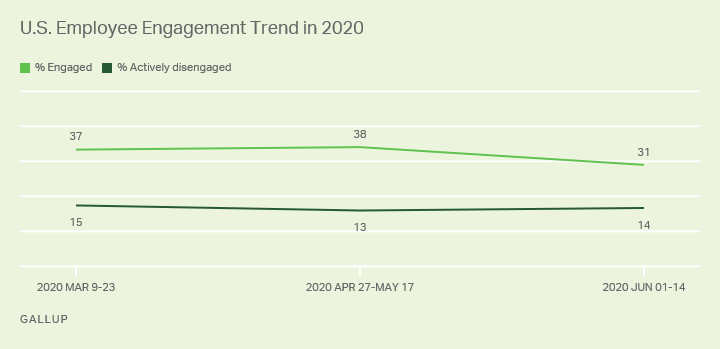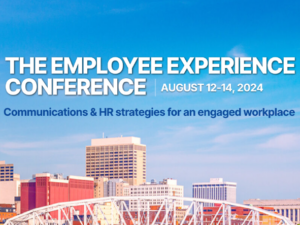Employee engagement takes a hit after months of crisis
The metric, seen as a good indicator of morale, productivity and whether your workers are looking for new jobs, had taken a historic rise. What’s behind the drop?

Employee engagement was at a historic high in May.
According to data from Gallup, the percentage of “engaged” workers in the U.S. reached 38%. However, following months of the COVID-19 pandemic and fallout in the wake of the death of George Floyd and subsequent protests, the numbers are back down to 31%.

However, the drop does not correspond to the percentage of employees who are “actively disengaged.” The newly unengaged workers don’t see themselves as having “miserable work experiences,” spreading their unhappiness to their colleagues. Those numbers are (relatively) static.
So, what is driving the change? Perhaps we can learn more by understanding who it is that is newly “unengaged.”
The largest decline in employee engagement was among those in managerial or leadership positions, as well as non-White respondents and those with Democratic political party affiliation or independents. The drop was also sharper for people working on-site versus at home as well as among blue-collar or service workers. The drop was larger for men than women.
So the drop comes from managerial, leadership level positions, with Democratic leaning politics. It comes from people who have been working on-site versus at home, particularly service and blue-collar workers.
COVID-19 explains some of that. The business response to the Black Lives Matter movement might explain some more, if we accept that the business response has been underwhelming. According to a report by Clutch, 65% of employees are satisfied with their organizations’ response to Black Lives Matter, which leaves 35% with a different view.
Certainly, business leaders should not assume that their Black Lives Matter responses have been enough.
However, two other considerations are suggested by Gallup:
1. The message has been muddled on returning to normal.
With different states opening up at different speeds—and a lack of clarity on what the future of this crisis holds—is it any surprise that employees are tuning out?
Messages and strategies that offered hope in March and April are well past their sell-by date in July.
It’s crucial for organizations to invest heavily in long-term planning and to communicate realistic expectations to workers who are closing in on six months of working from home. Add to that stress the beginning of a new school year, which in most cases will be at least partially remote, and constantly changing government guidance, and you’ve got a recipe for disengagement.
2. Previously furloughed workers have lost trust.
For organizations that have tried to bring back their furloughed workers—or perhaps are working through painful cost-cutting and layoffs—it’s important to acknowledge that you are mortgaging your relationship with your employees. Workers who have been furloughed are less likely to be engaged with their company, and even for workers who are kept on the payroll, staff reductions can engender distrust.
The top piece of advice from the data, per Gallup, is an emphasis on clear communication of expectations.
Improving employee engagement starts with clarity among leaders and managers. If leaders and managers are unclear in communicating about matters such as plans moving forward or how the organization is responding to racial injustice, then it is highly unlikely that their direct employees will have clarity on these things. And clarity is crucial, as more engaged leaders have more engaged managers who then have more engaged employees.
How are you working to build and sustain employee engagement within your organization? Share your thoughts in the comments, please.







